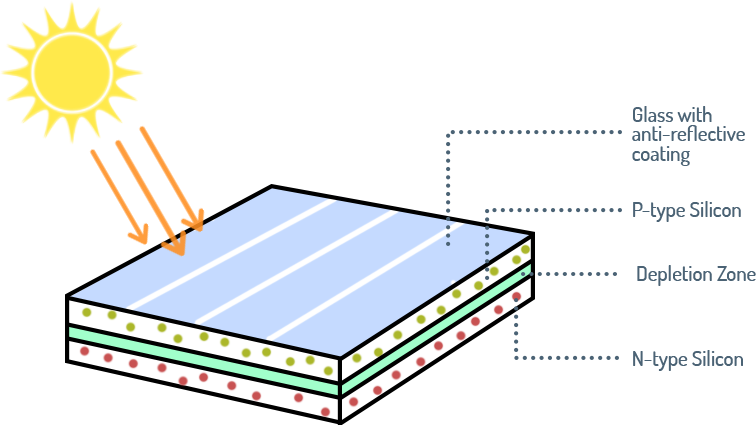SOLAR CELL STRUCTURE
Solar cells, also known as photovoltaic (PV) cells, are devices that convert light into electrical energy. Solar cells are made of semiconductor materials, such as Silicon. Solar cells also could be made of different materials, including solar inks, solar dyes, and conductive plastics.
The most common material currently used for solar cell production is Silicon, the semiconductor material, which means it can conduct electricity better than an insulator but not as well as a good conductor like a metal. The common solar cell is usually designed as a large-area p-n junction made from silicon. It can generate a maximum open-circuit voltage of approx. (0.5 – 0.6) volts.
The solar cell is composed of two types of semiconductors, p-type and n-type silicon, tightly bonded together. In the n-type layer, there is an excess of electrons, and in the p-type layer, there is an excess of positively charged holes.

Near the junction of the two layers, the electrons on one side of the junction (n-layer) move into the holes on the other side of the junction (p- layer). This forms an area around the connection, known as the depletion zone, in an attempt to fill the electron holes. Using illumination cells, current can be created, with no need to utilize chemical reactions or require fuel to produce electric power or have any moving parts.

When sunlight hits a solar cell, Silicon electrons are ejected, which results in the formation of the holes, which are the vacancies left behind by the escaping electrons. If this occurs in the electric field, the field will move electrons to the n-type layer and holes to the p-type layer. By connecting the layers of n-type and p-type using a conductive wire, the electrons pass through the depletion zone, and then go through the external wire back to the n-type layer, creating a flow of electricity.
The basic steps in the operation of a solar cell are :
1- Generation of light-generated carriers.
2- Collection of the light-generated carriers to generate a current.
3- Generation of a large voltage across the solar cell.
4- Dissipation of power in the load and parasitic resistances.
Share this post
